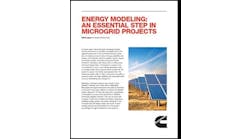Fairfield this week became the first town to begin operating a microgrid through Connecticut’s pioneering microgrid grants program.
The unveiling comes as the state prepares to launch its third round of community microgrid grants.
The next round is expected to differ from the earlier offerings in that applicants will be able to apply when they are ready, rather than adhere to a strict deadline. Therefore, projects will not compete against each other, but be judged based on their individual merit. The state chose earlier microgrid grant winners through competitive solicitations.
Connecticut began offering the community microgrid grants in 2012. So far the state has awarded $23 million to 11 projects. Fairfield received $1.1 million. (See details about the Fairfield microgrid in this case study.)
“We’re proud to help ensure efficient, clean and reliable energy for the residents of Fairfield even in the event of a natural disaster,” said Chris Bleuher, microgrid program business development manager for Schneider Electric, which installed the microgrid. “Fairfield has established itself as an early leader in microgrid development and serves as a model for other municipalities wishing to protect their critical facilities.”
***
Australia’s Carnegie Wave Energy says it will develop the world’s first wave energy microgrid connected to a central grid.
The Western Australian developer has signed an agreement with utility Western Power to deliver the 2-MW project to Garden Island, home of an Australian naval base.
The wave energy microgrid also will include a solar photovoltaic installation with a 2 MW peak capacity, energy storage and an existing reverse osmosis desalination plant, according to the developer.
Western Power will provide engineering assistance to enable a two-way flow of power between the central grid and the renewable energy microgrid.
Carnegie Wave Energy sees the project as a model for wave energy microgrids on islands and other remote communities.
***
Metropolitan Washington Council of Governments (MWCOG) has taken the next step in developing microgrids in Washington, D.C. by selecting a consultant: IPERC (Intelligent Power & Energy Research Corporation) and its partners, led by CHA Companies..
The contract is the result of a competitive solicitation issued by MWCOG in April.
Washington, D.C. is considered vulnerable to power outages because of its reliance on power imports. Last spring a broken transmission line knocked out power to the city and several key federal buildings, including the Department of Energy.
IPERC and partners will identify microgrid locations and configurations, and contribute to the design and installation of cybersecure microgrids.
MWCOG includes 22 local governments in Maryland, Washington DC, and Virginia regions.
***
Call it a microgrid, a nanogrid or an e-park, Vermont’s Emerald Lake State Park has an interesting energy project underway.
The grid-connected (for now) system will use solar plus Tesla Powerwall batteries. Eventually, the e-park will go permanently off-grid as utility lines are phased out.
Green Mountain Power has selected Pika Energy to provide the design, planning and expertise to develop the e-park.
Emerald Lake State Park experiences a lot of power outages due to fallen trees. Its transmission lines run through rough terrain, making repairs difficult. GMP officials say the system will cost 20 percent less than rebuilding the utility lines and save up to $8,000 annually in maintenance.
The project offers an example of how to solve the utility ‘last mile’ problem of delivering electricity to consumers at the end of the system.
Separately, GMP has ordered about 500 Tesla Powerwall batteries, to be delivered this fall, to support its ongoing effort to reduce fossil fuel reliance and bring more clean power to Vermont.
Want more microgrid news? Follow MicrogridKnowledge.com on Twitter @MicrogridNews.






